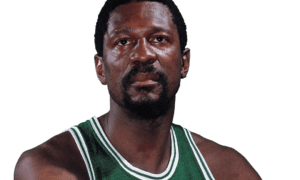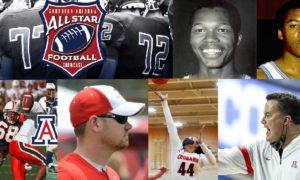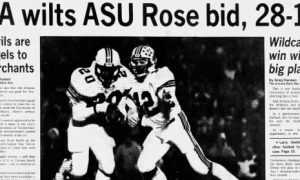Ernie McCray
EDITOR’S NOTE: Former Tucson High School and University of Arizona basketball standout Ernie McCray is a legendary figure to Tucsonans and Wildcat fans. McCray, who holds the Wildcats’ scoring record with 46 points on Feb. 6, 1960, against Cal State-Los Angeles, is the first African-American basketball player to graduate from Arizona. McCray, who now resides in San Diego, earned degrees in physical education and elementary education at Arizona. He is a longtime educator, actor and activist in community affairs in the San Diego-area. He wrote a blog for TucsonCitizen.com before the site ceased current-events operations last year. He agreed to continue offering his opinion and insight with AllSportsTucson.com. McCray also writes blogs for SanDiegoFreePress.org.
[rps-paypal]
[ezcol_1half id=”” class=”” style=””]
The madness in Charleston, to me, is so much deja vu because blacks being shot or bombed where they worship and pray is not something that’s new here in the USA.
In no way. These atrocities started, practically, when they shoved us off the ships to pick cotton, way, way back in the day.
And where’s a good place to find a lot of us to slay? Church. Makes sense to a hateful evil-minded KKK kind of person who all of a sudden, out of his madness, just can’t stand to see a Negro alive.
So he decides to mosey on down to where we’re on our knees filled with the Holy Ghost, feeling joy and hope, our bodies and souls moving to gospel songs that tell the story of power and glory, in their tone, in their very beat and tempo, in their drive, in their nuances… Our burdens are eased, if for just a little while…
“BOOM!!!” …
Nine fewer black people in the world…
And we just step on, as a nation, after these tragedies, dismissing them, basically, as more or less “unfortunate incidents” when we all know that they’re “racist incidents.”
When will we Americans ever sit down together or stand up together and acknowledge that racism has always and continues to deprive us of becoming our better selves – and get rid of it?
Oh, I know: “we don’t see color.” And this begs me to ask if we don’t see color how is it that we do see the plight of black people as the “The black problem” and, on top of that, we leave “The black problem” to be solved by just black people and, on top of that, we go on and on in social media and at Happy Hour about how black people aren’t doing enough to solve “The black problem.” We see what we want to see, don’t we?
[/ezcol_1half]
[ezcol_1half_end id=”” class=”” style=””]
Ernie McCray during his Arizona playing days. His 46 points in a 1960 game remains a school record (University of Arizona photo)
[/ezcol_1half_end]

Ernie McCray, far left, standing with political activist Angela Davis, far right
[ezcol_1half id=”” class=”” style=””]
Well, to set the record straight, working on “The black problem” is pretty much all some of us do, in one form or another. Going back centuries. Alongside allies of all colors and creeds, loving human beings who see “The black problem” for what it is: The American problem. A colossal problem at that.
And to mention a brother who has worked on “The black problem” for a very long time, I had the privilege, at a Pillars of the Community San Diego gathering not too long ago, of kicking back and listening to Elbert “Big Man” Howard – one of the founding fathers of the Black Panther Party.
As he spoke I couldn’t help but reminisce about those days back in the 60’s and 70’s. I was in my 20’s and my 30’s then, stepping tall, full of life, still could play a little ball, trying to make sense out of my world.
[/ezcol_1half]
[ezcol_1half_end id=”” class=”” style=””]
[/ezcol_1half_end]
I was fully in tune with what was going on and nobody captured my attention more than the Black Panther Party. They role modeled what making the world better for all people is all about. In a spirit of unadulterated love.
They lead rent strikes; hipped their community to politics and economics; stood with Cesar; fed children breakfast and distributed clothes to the poor; tested people for sickle cell disease; taught first aid and self-defense; created schools designed to liberate a human being’s body and soul; took care of the elderly; set up medical clinics that were free and emergency-response ambulance programs and drug and alcohol rehabilitation programs; transported families to visit their loved ones in prison.
They were as James Brown would say, “doing the do” with respect to addressing “The black problem.”
But here’s one of the ugliest truths I know: throughout our country’s history, whenever the powers-that-be get wind that black people are trying to better themselves – aka “something’s up” – they set out to destroy whatever that something is.
That’s to say that from the time the Black Panther Party called themselves such, Uncle Sam was there to put his touch on things.
J. Edgar Hoover, Mr. FBI, was up to his old tricks like when he tried to sabotage Martin and the “The Great Civil Rights Movement.”
His COINTELPRO pros worked non-stop, with all kind of money and resources at their disposal, to discredit, “by any means necessary” all the good work the Party was doing.
I couldn’t help, as I listened to “Big Man,” reflecting on the behavior of San Diego’s “Red Squad” back in those days. They knew how to divide and conquer with the best of them, pitting the local Black Panthers against another organization, stirring up raw emotions and tempers with their underground expertise.
Based on some of the clever devious lies these spies devised, homes were shot into; doors were knocked down and people beaten; a man was killed; lives were tattered; hopes and dreams were stilled.
Angela Davis was in San Diego during some of those days, studying at UCSD, helping local activists look for answers to “The black problem” in our communities.
And in swoops Governor Ronald Reagan like a bird of prey, bearing its talons, tearing at this brilliant woman’s left-leaning-radical-counterculture-scholarly politics which didn’t bother us in any way and it seemed I sneezed and she was on the FBI’s Most Wanted list. Wanted dead or alive. I’m talking racism as deep as the ocean and vast as the sky.
I look at Angela in a picture, from the 80’s, standing across from me, with my beautiful Nancy standing next to me and a woman, I vaguely remember, standing next to her. We were addressing, what else, “TBP.”
Here I am, still at it, along with others throughout our country, trying to assume some degree of responsibility for racism’s demise.
If more people, no matter their color, joined the struggle I’d like to think that “The black problem” would disappear in the winds of such social change, rendering confederate flags and the like, some day, as just reminders of when we didn’t have it together and then decided to finally seriously create a society wherein everyone had a reasonable opportunity to live with dignity.
When you’ve dealt with “The black problem” as long as I have you can’t help but think that way.
Meanwhile, may my beloved departed brothers and sisters in Charleston Rest in Peace.






























